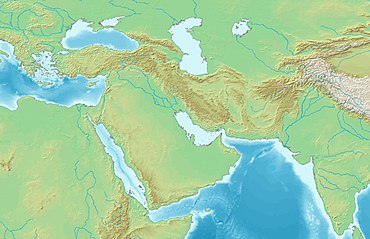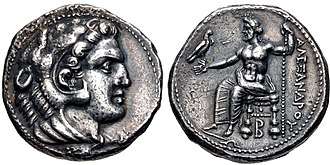Balakros
Balakros (Greek: Bάλακρoς), also Balacrus, the son of Nicanor, one of Alexander the Great's "Somatophylakes" (bodyguards), was appointed satrap of Cilicia after the Battle of Issus, 333 BC.[2] He succeeded to the last Achaemenid satrap of Cilicia, Arsames.
Balakros | |
|---|---|
 Coin of Balakros, Satrap of Cilicia, with letter "B" next to the shield, standing for B[AΛAKPOI].[1] Tarsos. 333-323 BC. | |
| Allegiance | Macedonian Empire |
| Years of service | fl. 333 – 323 BC |
| Rank | Somatophylakes (bodyguard) Of Alexander the Great Satrap of Cilicia |
| Battles/wars | Asia Minor campaigns |
| Spouse(s) | Phila of Macedonia |


Career
Balakros completed the conquest of Asia Minor together with Calas, satrap of Hellespontine Phrygia, and Antigonus, satrap of Phrygia.[3]
It was probably this Balacrus who married Phila, the daughter of Antipater, and subsequently the wife of Craterus.[4]
He was probably supervised by Menes from 331 BC, who held the position of Hyparch or Strategoi for the area from Babylon to the satrapies of Syria, Phoenicia, and Cilicia.
He fell in battle against the Pisidians in the lifetime of Alexander.[5] His death is variously placed circa 328 BC or 323 BC.[6][7]
Coinage
Balacrus is among several Hellenistic satraps who continued to use an Achaemenid type for their coinage, complete with the local deity of Tarsus, Baal.[8] His coinage bore his name, and later only his initial "B".[3] This coinage is said to have influenced Alexander's imperial coinage, which was initially minted in the same mints.[8] The Imperial coinage of Alexander is often said to have been started in Tarsos circa 333-327, under the rule of either Balacrus or Menes.[9]


 Coin of Balakros, Satrap of Cilicia, with letter "B". Tarsos. 333-323 BC
Coin of Balakros, Satrap of Cilicia, with letter "B". Tarsos. 333-323 BC Possible coinage of Balakros, with the letters "B-A".
Possible coinage of Balakros, with the letters "B-A".
References
Notes
| Wikimedia Commons has media related to Balakros. |
- Rider, Georges Le (2007). Alexander the Great: Coinage, Finances, and Policy. American Philosophical Society. p. 153. ISBN 9780871692610.
- Arrian, Anabasis Alexandri, ii. 12
- Heckel, Waldemar (2008). Who's Who in the Age of Alexander the Great: Prosopography of Alexander's Empire. John Wiley & Sons. p. 84. ISBN 9781405154697.
- Photius, Bibliotheca, cod. 166
- Diodorus Siculus, Bibliotheca, xviii. 22
- Carradice, Ian; Price, Martin (1988). Coinage in the Greek World. Seaby. p. 110. ISBN 9780900652820.
- Levante, Edoardo (1993). Cabinet des médailles, Cilicie (in French). Bibliothèque nationale. ISBN 9782717718768.
- Mildenberg, Leo (2000). On the so-called satrapal coinage. p. 10 and Note 8.
- Howgego, Christopher (2002). Ancient History from Coins. Routledge. p. 49. ISBN 9781134877843.
![]()